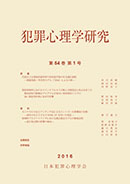
- Issue 2 Pages 1-
- Issue 1 Pages 1-
- |<
- <
- 1
- >
- >|
-
Hideo Kondo, Hisanao Takahashi2009Volume 47Issue 1 Pages 1-19
Published: July 31, 2009
Released on J-STAGE: September 30, 2017
JOURNAL FREE ACCESSThe creation of structured risk assessment instruments to support judicial decision making has been an important issue in the juvenile justice systems of Japan. We analyzed the recidivism of 1,080 delinquents who were released from a Juvenile Classification Home. The recidivism risk factors were separated into seven categories such as antisocial attitudes and substance abuse, and a survival analysis based on Cox's proportional hazard model was performed for each of the categories to determine which factors affected recidivism. From the results of these analyses, many static and dynamic factors were identified as factors affecting risk. Furthermore, a prototype for risk assessment was created from the 19 risk factors obtained by analyzing all categories, which enabled accuracy to be obtained above a certain level. This research has shown that it should be possible to build a practical and accurate risk assessment for Japan by including an even wider range of risk factors based on this research.
View full abstractDownload PDF (14421K)
-
Yoshiko Fujii2009Volume 47Issue 1 Pages 21-35
Published: July 31, 2009
Released on J-STAGE: September 30, 2017
JOURNAL FREE ACCESS -
Kohske Ogata2009Volume 47Issue 1 Pages 37-45
Published: July 31, 2009
Released on J-STAGE: September 30, 2017
JOURNAL FREE ACCESSThe purpose of my study was investigating the aggression of maltreated children from responses to the Rosenzweig Picture–Frustration Study (P–F). P–F scoring sheets of 215 children (65 maltreated, 150 comparison) in the Child Guidance Centers were examined retrospectively. Analyses were conducted firstly by comparing the means of the maltreated group with theoretical means (norms) obtained in the process of standardization in Japan, and then by testing the differences of means between the groups in the present research. As results of MANOVA and t-test corrected by Bonferroni method, the standardized scores of maltreated group was higher than those of comparison on the intra-aggression (I-A) and the group conformity rating (GCR), while the maltreated have lower scores of the extra-aggression (E-A). The higher I-A in maltreated children was probably resulted from the inhibition of E-A, and the higher GCR appeared to be over-adaptation. In consideration of the previous studies, it was suggested that maltreated children have tendencies to inhibit their aggression with the risk of being abused and to release their aggression without the risk.
View full abstractDownload PDF (6736K) -
Sonomi Hirata, Hiroshi Oura2009Volume 47Issue 1 Pages 47-57
Published: July 31, 2009
Released on J-STAGE: September 30, 2017
JOURNAL FREE ACCESSThis paper deals with the differences in the perception towards classroom environments between secondary students and juvenile delinquents in Japan. The actual and preferred forms of the original classroom environment scale were both administered to 121 students from secondary school, and 87 correctional institution residents. The results were analyzed using the two-way ANOVA with two-by-two factorial design. The independent variables are Forms (Actual/Preferred) and Groups (Secondary school students/Delinquent students). Statistically significant differences were found between students' actual and preferred environment on Teacher Support, Sense of Isolation, Deviation from Class, and Order & Organization. Concerning Teacher Support, juvenile delinquents reported that they are asking closer relationship with a teacher more than non-delinquents. Also it was shown that the delinquent students felt the stronger pressure of the Achievement Responsibility. These findings are consistent with the arguments of several major research based on Hunt's (1975) Person-Environment fit theory (Fraser & Fisher, 1983; Stern, 1970), and finally lead to the conclusion that it is beneficial to measure the delinquent students' perceptions of actual and preferred classroom environment to restrain them from misconduct and maladjustment to school.
View full abstractDownload PDF (8223K) -
Kenji Omata2009Volume 47Issue 1 Pages 59-73
Published: July 31, 2009
Released on J-STAGE: September 30, 2017
JOURNAL FREE ACCESSArchitectural and areal characteristics of high-rise residences with high victimization rates, high residents' anxiety about crime and high crime risk perception were investigated to identify environmental psychological factors related to crime prevention in such apartments. Housing developments (n=56) consisting of single or multiple blocks were investigated by requesting adult female residents to respond to a questionnaire. Results indicated the following. (1) When the residents' satisfaction with lighting was high, the total crime-rate was low, as was the number of break-ins. (2) The crime-rate related to bicycle and motor vehicle thief was high in high-rise apartments that were located in inconvenient and less ordered areas. (3) Sexual crime occurred more in suburban areas than in urban areas. These findings indicated that the environmental factors affecting the crime rate depended on the type of crime. (4) Anxiety and perception of crime risk was strongly related to the degree of satisfaction with lighting. The number of fearful places, anxiety about crime at night, as well as the perception of risk for three of four types of crime was improved by better lighting. Although further investigations are needed, these results provide suggestions for crime prevention in residential area in Japan, where the need for high-rise housing is increasing.
View full abstractDownload PDF (11823K)
-
Wataru Zaitsu2009Volume 47Issue 1 Pages 75-87
Published: July 31, 2009
Released on J-STAGE: September 30, 2017
JOURNAL FREE ACCESSDownload PDF (10746K)
-
Osamu Yamazaki2009Volume 47Issue 1 Pages 89-93
Published: July 31, 2009
Released on J-STAGE: September 30, 2017
JOURNAL FREE ACCESSDownload PDF (3834K)
- |<
- <
- 1
- >
- >|